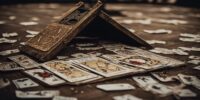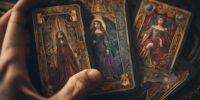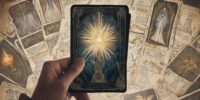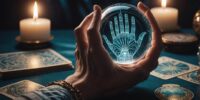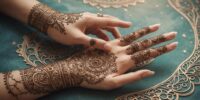How to Differentiate Between Tarot and Oracle Cards: Historical Context
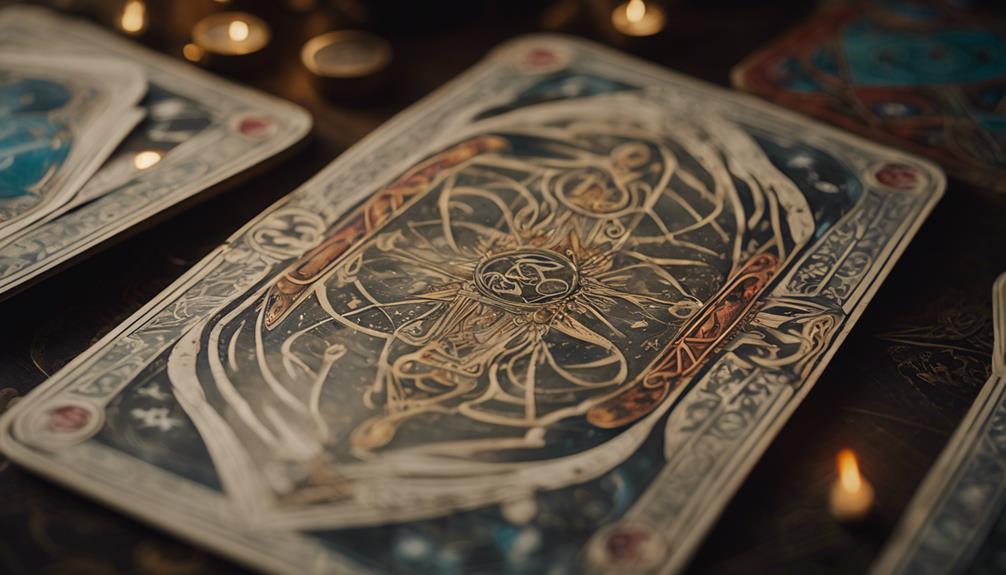
Tarot cards have a long history, dating back to the 15th century in Europe. They were originally used for playing card games before evolving into a tool for divination and spiritual guidance. The traditional tarot deck consists of 78 cards, divided into two main sections: the Major Arcana and the Minor Arcana. Each card has its own symbolic meaning and interpretation, making tarot a complex and detailed system for exploring life's challenges and opportunities.
On the other hand, oracle cards are a more modern invention, with no specific historical roots. They are usually thematic, focusing on specific topics like angels, fairies, animals, or affirmations. Oracle decks can vary in size, from as few as 20 cards to over 100, and they are designed to offer more straightforward and intuitive messages compared to tarot. While tarot cards follow a structured system with established meanings, oracle cards provide more flexibility for interpretation and personal reflection.
In summary, tarot cards have a rich historical background and a structured system of symbols and meanings, making them a detailed tool for divination and self-discovery. Oracle cards, on the other hand, are a more modern and flexible form of divination, often focused on specific themes and offering intuitive guidance for everyday situations. Both types of cards can be powerful tools for introspection, insight, and spiritual growth.
Origins of Tarot Cards
Having originated in Europe during the late 14th century, Tarot cards are known for their rich symbolism and mystical allure. These cards hold immense historical significance, tracing their roots back to the courts of Italian nobility. Initially used as playing cards, Tarot decks evolved to encompass allegorical illustrations and esoteric meanings, becoming tools for divination and spiritual exploration. The card origins are shrouded in mystery, with some attributing them to ancient Egyptian wisdom, while others link them to medieval European mysticism.
The historical significance of Tarot cards lies in their transformation from a recreational pastime to a powerful medium for self-reflection and guidance. The intricate designs and archetypal symbols featured in Tarot decks have captured the imagination of seekers for centuries, offering a mirror to the subconscious mind and a gateway to higher wisdom. As individuals explore the world of Tarot, they set off on a journey of self-discovery and empowerment, revealing the secrets of the universe one card at a time.
Development of Oracle Cards
The evolution of Oracle cards from their Tarot predecessors marks a significant shift towards more personalized and intuitive forms of spiritual guidance and introspection. Oracle card evolution has seen a departure from the structured framework of Tarot decks, allowing for greater creative expression and diversity in the deck designs. This development has enabled Oracle cards to cater to a broader audience seeking a more personalized approach to divination and self-reflection.
Symbolism development within Oracle cards has embraced a wide range of themes, from nature and animals to angels and mythical creatures, offering a rich tapestry of imagery for interpretation. Unlike the traditional Tarot deck, which follows a specific set of archetypes and symbols, Oracle cards have the freedom to draw inspiration from various sources, making them versatile tools for exploring different aspects of life and spirituality.
Through the continuous evolution of Oracle cards, individuals are encouraged to trust their intuition and connect with the symbols and messages that resonate with them personally, fostering a deep sense of empowerment and self-awareness. The development of Oracle cards has indeed opened new pathways for spiritual seekers to commence on a journey of self-discovery and inner wisdom.
Symbolism in Tarot Decks
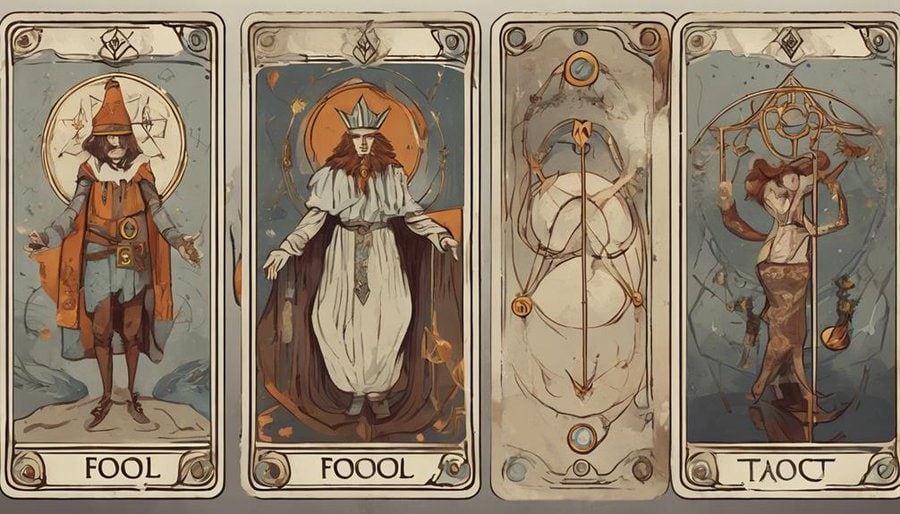
Within the intricate tapestry of Tarot decks lies a rich array of symbols waiting to be deciphered. These symbols aren't mere random illustrations but carry profound meanings that speak to the subconscious mind.
Tarot Symbolism Overview
Symbolism in Tarot decks serves as a profound language that communicates intricate meanings through visual imagery and archetypal symbols. Rooted in the tarot origins, these symbols have evolved over centuries to encapsulate profound wisdom and spiritual truths.
Each card in a Tarot deck holds a unique symbolical representation, from the Fool's journey of new beginnings to the High Priestess's intuitive wisdom. The Major Arcana embodies significant life events and spiritual lessons, while the Minor Arcana explores into everyday experiences and challenges.
The imagery in Tarot decks is rich with symbolism, inviting readers to explore the depths of their subconscious and connect with universal energies. Understanding the symbolism within Tarot cards can reveal layers of meaning and guidance for those seeking insight and introspection.
Oracle Deck Symbols
Exploring the domain of Oracle Deck symbols reveals a tapestry of mystical meanings woven into visual representations and archetypal motifs. Oracle deck meanings often convey deep insights and intuitive messages, distinct from traditional tarot card interpretations.
Here are four key elements that enrich the symbolism within Oracle Decks:
- Nature: Symbolizing growth, transformation, and harmony with the universe.
- Animals: Representing instinctual wisdom, guidance, and connection to the natural world.
- Celestial Bodies: Signifying cosmic influences, cycles, and spiritual enlightenment.
- Elemental Forces: Depicting the primal energies of earth, air, fire, and water, influencing life's aspects.
Each symbol in Oracle Decks acts as a portal to the subconscious, inviting seekers to explore their inner truths and embrace personal freedom.
Diversity in Oracle Card Themes
Diverse in their themes, Oracle cards offer a rich tapestry of symbols and messages for seekers to explore. The beauty of Oracle decks lies in their theme exploration and artistic diversity, which allow for a thorough exploration into various aspects of life and spirituality. These cards encompass cultural representation and symbolic variety, catering to a wide range of individuals seeking guidance and insight. Each deck is a unique masterpiece, weaving together a blend of imagery and symbolism that resonates with the human experience on multiple levels.
From nature-inspired themes to cosmic motifs, Oracle cards provide a platform for creative expression and interpretation. The diversity in themes not only reflects the rich tapestry of human culture but also offers a fresh perspective on life's complexities. Whether delving into mythical realms or exploring the depths of emotions, Oracle cards beckon the seeker to engage in a journey of self-discovery and enlightenment. Through their varied themes, these cards empower individuals to connect with their inner wisdom and intuition, fostering a sense of liberation and authenticity in their spiritual endeavors.
Historical Use of Tarot Cards
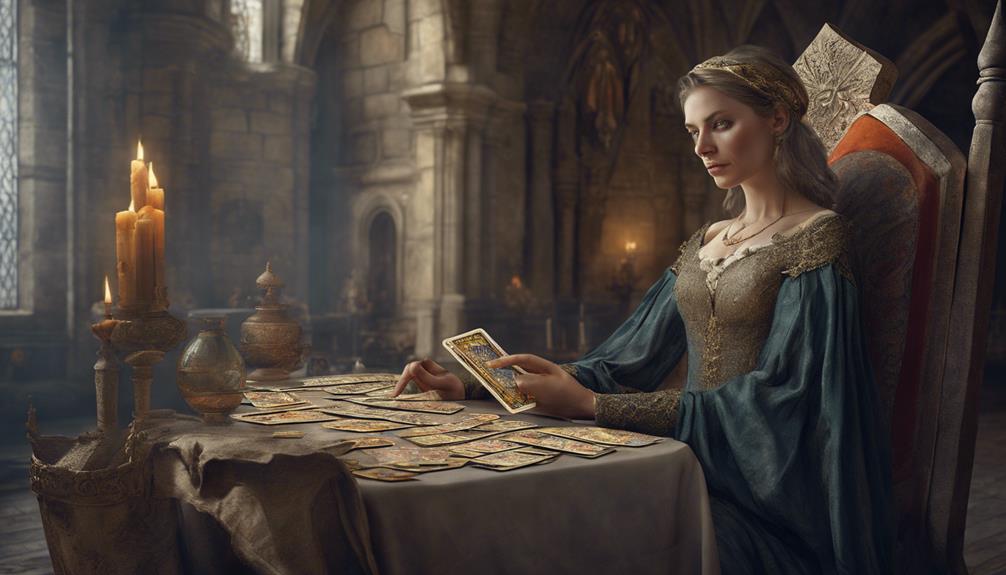
In tracing the roots of divination practices, the historical use of Tarot cards emerges as a fascinating journey through time and culture. Tarot cards have a deep historical relevance and spiritual significance that have captivated individuals for centuries. Here are four key aspects that shed light on the historical use of Tarot cards:
- Origin: The origins of Tarot cards can be traced back to the 15th century in Europe, where they were initially used as playing cards before evolving into tools for divination and spiritual guidance.
- Symbolism: Each card in a Tarot deck is rich in symbolism, drawing from various cultural and mystical traditions to convey profound messages and insights.
- Spread: Tarot cards are typically laid out in specific patterns known as spreads, each carrying its own unique interpretation and significance in a reading.
- Evolution: Over the centuries, Tarot decks have evolved in design and interpretation, reflecting the changing spiritual beliefs and practices of different eras.
Evolution of Oracle Card Designs
The evolution of oracle card designs showcases a fascinating journey of visual symbolism progression and the enduring influence of various art styles.
From traditional motifs to contemporary interpretations, each deck represents a unique fusion of artistic expression and spiritual insight.
Exploring these shifts in design offers a profound glimpse into the ever-evolving landscape of divination tools.
Visual Symbolism Progression
With each passing era, the intricate evolution of Oracle card designs reveals a rich tapestry of visual symbolism that captivates and transcends the boundaries of time and culture. The progression of visual symbolism in Oracle cards is a testimony to the fluidity of human expression and creativity. This evolution can be witnessed through:
- Ancient Hieroglyphics: Reflecting the mystical allure of ancient civilizations.
- Medieval Iconography: Infusing religious and mythological motifs into the imagery.
- Renaissance Artistry: Embracing a harmonious blend of realism and symbolism.
- Modern Abstraction: Breaking free from traditional constraints, offering open-ended interpretation.
Each stage in this symbolic journey adds layers of meaning and depth, inviting individuals to explore the boundless worlds of imagination and interpretation.
Influence of Art Styles
Emanating a diverse array of artistic influences, the evolution of Oracle card designs unfolds as proof of the ever-changing landscape of creative expression.
Artistic evolution within Oracle cards showcases a dynamic fusion of traditional and contemporary art styles. From intricate illustrations to abstract representations, each deck reflects the artist's unique vision and interpretation of symbolic imagery.
The incorporation of various art styles allows for a rich tapestry of visual storytelling, inviting users to explore the depths of symbolic interpretation in a visually enthralling manner.
As artists continue to push boundaries and experiment with different techniques, Oracle card designs evolve, resonating with individuals seeking a deeper connection to the cards' meanings through the fusion of art and symbolism.
Cultural Influences on Tarot
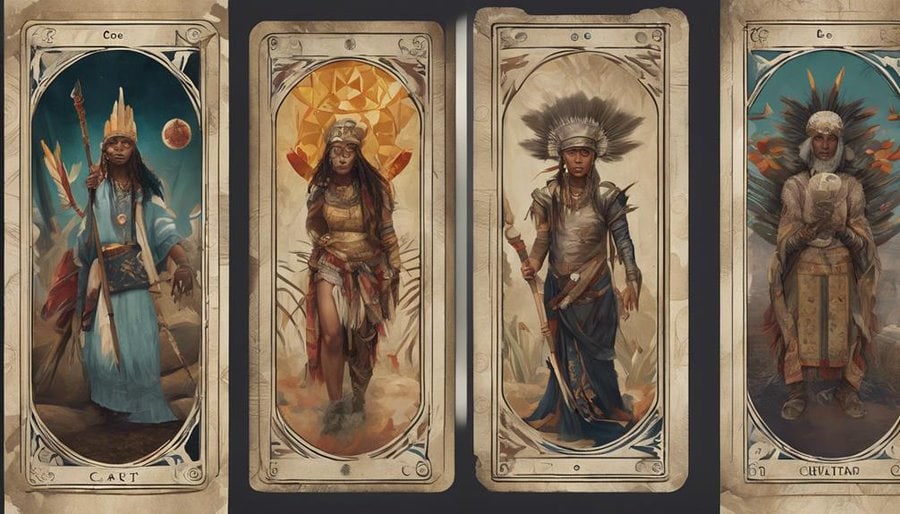
Influences from diverse cultural backgrounds have greatly shaped the development of Tarot, enriching its symbolism and interpretations. This fusion of cultural influences and traditional practices has imbued Tarot with a depth and richness that resonate with seekers worldwide.
Here are some key cultural influences that have left a lasting mark on Tarot:
- Egyptian Symbolism: The imagery in Tarot decks often draws inspiration from ancient Egyptian iconography, incorporating symbols like the Ankh and the Sphinx to deepen the mystical allure of the cards.
- Christian Mysticism: Elements from Christian traditions, such as angels, demons, and biblical stories, have been woven into the Tarot narrative, adding layers of meaning and spiritual significance.
- Romani Folklore: The Romani people, also known as Gypsies, have contributed to Tarot through their folklore and mystical beliefs, infusing the cards with a sense of wanderlust and fortune-telling mystique.
- Medieval European Alchemy: References to alchemical symbols and practices from medieval Europe can be found in Tarot, connecting the cards to the quest for spiritual transformation and enlightenment.
Modern Applications of Oracle Cards
The evolution of Tarot's cultural tapestry has paved the way for a modern renaissance in the utilization of Oracle cards for contemporary spiritual guidance and introspection. Oracle cards have emerged as powerful modern tools that offer seekers a different approach to intuitive readings and personal growth. Unlike the structured system of Tarot, Oracle cards provide a more fluid and open-ended platform for exploration, allowing individuals to commence into their intuition and connect with universal energies in a deeply personal way.
In today's fast-paced world, Oracle cards offer a quick yet profound way to receive spiritual guidance and insight. They serve as mirrors to our inner selves, reflecting back truths and wisdom that can aid in self-discovery and healing. Whether used for daily reflections, deep inner work, or simply as a source of inspiration, Oracle cards have found a special place in the hearts of those seeking to navigate life's complexities with grace and clarity.
Embracing the versatility and contemporary relevance of Oracle cards can empower individuals to set out on a journey of self-discovery and spiritual growth with confidence and authenticity.
Frequently Asked Questions
Are There Any Specific Rituals or Practices Associated With Using Tarot or Oracle Cards?
Incorporating ritualistic practices enhances the spiritual connection when using tarot or oracle cards. Energy cleansing and card charging are common ways to maintain a pure and vibrant energy flow, enriching the divination experience.
Can Tarot or Oracle Cards Be Used for Predicting the Future?
Tarot and oracle cards can be used for future predictions, but ethics play a significant role. Divination is possible, but skepticism is wise. Users should approach these practices with respect and mindfulness towards the unknown.
How Do Tarot and Oracle Card Readings Differ in Terms of Interpretation?
In interpreting tarot and oracle card readings, the key lies in understanding the differences in symbolism analysis. Tarot cards typically follow a structured system with defined meanings, while oracle cards offer more fluidity and personal interpretation.
Are There Any Famous Historical Figures Who Were Known to Use Tarot or Oracle Cards?
Famous figures throughout history, like Queen Elizabeth I and Carl Jung, embraced tarot and oracle cards in their practices. These historical practices not only added depth to their wisdom but also showcased the timeless allure of divination.
What Are Some Common Misconceptions About Tarot and Oracle Cards That People May Have?
Misconceptions about tarot and oracle cards often revolve around their purpose and usage. Clarifications can help distinguish similarities and differences between the two. Exploring rituals and practices associated with each can dispel common misunderstandings.

